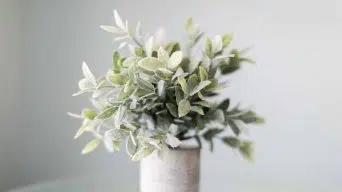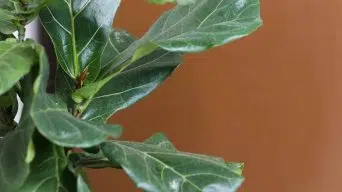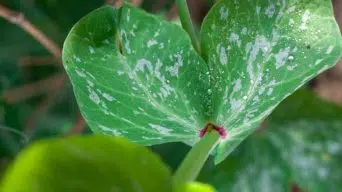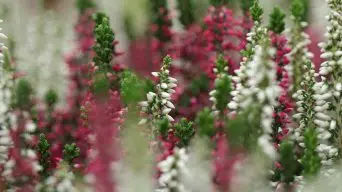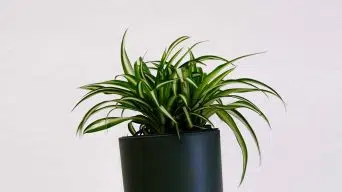Houseplants are a great way to bring some life into your home, but they can also be frustrating when leaves start curling.
While it may be tempting to ignore the problem, leaves that are curling could be an indication of a more serious issue.
But don’t worry – it’s easy to fix in most cases.
Here we’ll discuss the most common causes of curling leaves on houseplants and how to solve them.
Why Are My Indoor Plant Leaves Curling and How Can You Fix It?
If you notice your houseplant leaves curling, it’s essential to take a closer look at the plant.
There are several reasons why leaves may curl, and each one requires a different solution.
Let’s take a look at some of the most common causes:
1. Not Enough Water
One of the most common reasons for houseplant leaves to curl is simply that they’re not getting enough water.
When plants don’t get enough water, their leaves will wilt and eventually curl up as a defense mechanism to prevent further water loss.
The first sign of underwatering is usually wilting leaves, so it’s important to water plants as soon as you see this symptom.
The most common signs of underwatering are:
- Wilting leaves
- Dry soil
- Brown, crispy leaves
How To Fix It
If you think your plant is not getting enough water, the first thing to do is check the soil.
Stick your finger in the soil up to the second knuckle; if it feels dry, it’s time to water.
Water plants thoroughly until water runs out of the drainage holes at the bottom of the pot.
Don’t water again until the soil is dry to the touch.
It’s important to water deeply, rather than frequently, to encourage plants to develop strong roots.
Also, make sure you’re watering with room temperature water, as cold water can shock the plant and cause
2. Overwatering
Conversely, overwatering is also a common reason for houseplant leaves to curl.
When plants are overwatered, their roots can’t get the oxygen they need to function correctly, which leads to several problems, including leaf curling.
The most common signs of overwatering are:
- Soil that stays soggy or moist
- Leaves that are yellow or brown
- Root rot
- Fungus or mold growth
- A musty smell
How To Fix It
If you think you’re overwatering your plant, the first thing to do is check the soil.
Stick your finger in the soil; if it feels soggy or wet, it’s time to let the plant dry out.
Stop watering for a week or so and see if the plant improves.
If the soil is still wet after a week, you may need to repot the plant into fresh soil.
Ensure you’re only watering when the soil is dry to the touch and that you’re not overcompensating for previous periods of drought.
Also, ensure you’re using a pot with drainage holes to prevent waterlogging.
3. Low Humidity
Another common reason for curling leaves is low humidity.
Many houseplants originate from tropical regions where the air is very humid, so they’re used to high moisture levels in the air.
When the air is too dry, it can cause plants’ leaves to curl up as a defense mechanism.
The most common signs of low humidity are:
- Dry, crispy leaves
- Brown tips on leaves
- Leaves that curl or wilt
How To Fix It
If you think low humidity is causing your plant’s leaves to curl, you can do a few things to increase the humidity around your plant.
One way is to mist the leaves with water every few days.
You can also place the plant on a pebble tray filled with water, which will help to increase the humidity around the plant.
Another option is to use a humidifier, which will help raise the overall humidity in your home.
4. Temperature Stress
Temperature stress is another common cause of curling leaves on houseplants.
Most houseplants are native to tropical or subtropical regions and prefer warm temperatures.
When the temperature drops, the leaves may curl to conserve heat.
If the temperature is too cold, you may see wilted, soft, and droopy leaves in addition to being curled. In severe cases, the plant may go into shock and lose all its leaves.
The leaves may become dry and brown around the edges if the temperature is too high.
To prevent temperature stress, try to keep your houseplant in a room that stays between 65 and 75 degrees Fahrenheit.
If possible, avoid placing them near windows where they may be exposed to drafts.
How To Fix It
The solution to temperature stress is to move your plant to a location that is more suitable for its needs.
If the temperature is too cold, move it closer to a heat source or add a humidifier to the room.
If the temperature is too hot, move it to a cooler location or add a fan to the room.
You may also need to adjust the amount of light the plant is getting if it’s in a location where the temperature fluctuates frequently.
Most houseplants do best in a location that is out of direct sunlight and away from drafts.
5. Too Much Sunlight
While most houseplants need some sunlight to grow, too much sun can cause leaf curling.
Direct sun can be too intense for many houseplants, causing their leaves to curl up as a defense mechanism.
If the leaves are exposed to direct sunlight for too long, they may get sunburned, which will cause the leaves to curl up or turn brown.
The most common signs of too much sunlight are:
- Leaves that are yellow or pale green
- Brown spots on leaves
- Leaves that curl or wilt
- Leaves that turn white
How To Fix It
If you think your plant is getting too much sunlight, the best thing to do is move it to a location with indirect light.
You can place it near a window that gets indirect sunlight or in a room with bright indirect light.
East- and west-facing windows are usually the best option for most houseplants.
If you can’t move your plant to a different location, you can also try covering it with a sheer curtain or placing it in a room with white walls to reflect light.
You may need to adjust the amount of water you’re giving your plant if it’s in a location with more light than it’s used to.
Plants in brighter locations often need to be watered more frequently than those in lower-light conditions.
6. Nutrient Deficiencies
Nutrient deficiencies are another common cause of curling leaves on houseplants.
When plants don’t have enough nutrients, they may experience stunted growth and yellow or pale leaves. In some cases, the leaves may also start to curl.
The most common nutrient deficiencies that cause plant leaf curling are:
- Nitrogen: Leaves may be pale green or yellow and have stunted growth.
- Phosphorus: Leaves may be dark green with purple or red veins.
- Potassium: Leaves may be yellow or brown with stunted growth.
How To Fix It
If you think your plant is suffering from a nutrient deficiency, the best thing to do is fertilize it.
You can use a liquid fertilizer or slow-release pellets designed for houseplants.
Generally, it’s best to fertilize your plants once a month during the growing season and stop fertilizing them altogether during the winter.
Put the fertilizer in the soil around the plant, careful not to get any on the leaves. This can burn the leaves.
7. Too Much Fertilizer
While plants need nutrients to grow, too much fertilizer can be just as harmful as not enough.
If you fertilize your plant more often than necessary or use a fertilizer with a high concentration of nutrients, it can cause the leaves to curl.
This is because the excess nutrients in the soil can build up and burn the roots of the plant.
The most common signs of too much fertilizer are:
- Brown or yellow leaves
- Leaves that curl or wilt
- Stunted growth
- Salt buildup on the surface of the soil
How To Fix It
If you think your plant is getting too much fertilizer, the best thing to do is flush the soil.
Place your plant in a sink or tub and run water through the soil for a few minutes.
This will help to remove some of the excess fertilizer from the soil.
You can also try leaching the soil by adding water to the pot and draining it several times.
If you’re using a liquid fertilizer, make sure you’re diluting it correctly according to the manufacturer’s instructions.
You should also be sure to fertilize your plants only as often as necessary.
Most houseplants need to be fertilized once a month during the growing season and not during winter.
8. Pest Infestation
Pests are another common cause of curling leaves on houseplants.
Several pests can attack houseplants, including aphids, mealybugs, spider mites, and whiteflies.
These pests can cause your plant’s leaves to curl, discolor, or drop off entirely.
They can also lead to stunted growth and a general decline in your plant’s health.
Pests usually attack already stressed plants, so it’s essential to keep your plants healthy and free of stressors to prevent an infestation.
How To Fix It
If you think your plant is infested with pests, the best thing to do is isolate it from other plants.
This will help to prevent the pests from spreading.
Then, remove the pests from the plant using a cotton swab dipped in rubbing alcohol.
You can also use neem oil or insecticidal soap to get rid of the pests.
These products are safe to use on houseplants and will not harm you or your pets.
You may need to treat your plant several times before the pests are completely gone.
9. Soil Issues
The type of soil you use can also cause your plant’s leaves to curl.
If the soil is too dense, it can prevent the roots from getting the oxygen they need to function properly.
This can lead to stress on the plant, which can cause the leaves to curl.
Soil that is too sandy or too clay-like can cause plant problems.
The best type of soil to use for houseplants is a well-aerated, well-draining potting mix.
You can tell if your soil is too dense by feeling it.
If it feels compacted or water runs off of it instead of soaking in, it’s too dense.
How To Fix It
If your soil is too dense, you can add some perlite or vermiculite to it.
This will help to aerate the soil and improve drainage.
If your soil is too sandy or clay-like, you can add some organic matter to it.
This will help to hold moisture and nutrients in the soil.
For most houseplants, a potting soil mix that contains peat moss, perlite, and vermiculite is a good option.
This type of potting mix provides good drainage and aeration while still holding moisture and nutrients.
10. Transplant Shock
Transplanting your plant can also cause the leaves to curl.
When you transplant a plant, it’s essential to be careful not to damage the roots.
If the roots are damaged, it can lead to stress on the plant and cause the leaves to curl.
It can also take a while for a plant to adjust to a new pot or location.
During this adjustment period, the plant may experience stress, which can cause the leaves to curl.
How To Fix It
If you think your plant is suffering from transplant shock, the best thing to do is give it time.
Most plants will recover from transplant shock within a few weeks.
During this time, it’s essential to keep the plant well-watered and avoid fertilizing it.
Fertilizing a plant that is already under stress can do more harm than good.
How To Prevent Houseplant Leaves From Curling
The best way to prevent houseplant leaves from curling is to provide the plant with the proper care.
You can take some steps to prevent stress on your plant and keep it healthy.
Here are some tips:
1. Provide the Plant With Proper Lighting
One of the most important things you can do for your plant provides it with proper lighting.
Most houseplants need bright, indirect light to grow properly.
If your plant isn’t getting enough light, it will start to stretch, which can cause the leaves to curl.
You can prevent this by placing your plant in a spot where it will get bright, indirect light.
You can use grow lights if you can’t provide your plant with enough natural light.
2. Water the Plant Properly
Another essential thing to do for your plant is to water it properly.
Overwatering and underwatering can cause stress on a plant, leading to the leaves curling.
To water your plant correctly, you should check the soil before watering.
If the soil is dry, water the plant.
If the soil is wet, wait a few days before watering again.
3. Use the Right Soil
As we mentioned earlier, the type of soil you use can also affect your plant.
It’s important to use a well-aerated, well-draining potting mix for most houseplants.
This potting mix will help prevent the roots from getting too wet or too dry.
4. Avoid Fertilizing Too Much
Fertilizing your plant is essential, but you should avoid fertilizing too much.
Overfertilizing can cause stress on the plant, which can lead to the leaves curling.
It’s best to fertilize your plant every two weeks or so during the growing season.
5. Avoid Temperature Extremes
Another thing to avoid is temperature extremes.
Both hot and cold temperatures can cause stress on a plant, leading to the leaves curling.
To prevent this, you should place your plant in an area where the temperature is consistent.
You should also avoid placing your plant near drafts or heat sources.
6. Prune Your Plant
Pruning your plant is also important.
Pruning helps to promote new growth and can help prevent your plant from getting too big.
It’s best to prune your plant every few months or so.
7. Provide Enough Humidity
Another thing to consider is humidity.
Many houseplants need high humidity to grow properly.
If your home is too dry, it can cause stress on the plant, leading to the leaves curling.
You can provide your plant with enough humidity by placing it on a pebble tray or using a humidifier.
8. Keep Your Plant Clean
It’s also essential to keep your plant clean.
Dust and dirt can build up on the leaves, which can block the pores and cause the plant to suffocate.
To prevent this, you should wipe the leaves down with a damp cloth every week or so.
By taking these steps, you can help prevent your plant from experiencing stress, leading to the leaves curling.
9. Keep an Eye on Your Plant
Even if you take all of these steps, there’s always a chance that your plant will experience stress.
That’s why it’s important to keep an eye on your plant and pay attention to any changes.
If you notice the leaves starting to curl, you can try one of the solutions we listed above.
By taking good care of your plant and being observant, you can help prevent the leaves from curling.
Final Thoughts
Houseplants are a great way to liven up any room, but they can be frustrating when their leaves start to curl.
Curling leaves can be caused by several factors, including too little water, too much sunlight, or pests.
Fortunately, you can do a few things to fix the problem.
You can keep your houseplants healthy and happy by understanding the causes of curling leaves and taking some simple steps to correct the issue.


